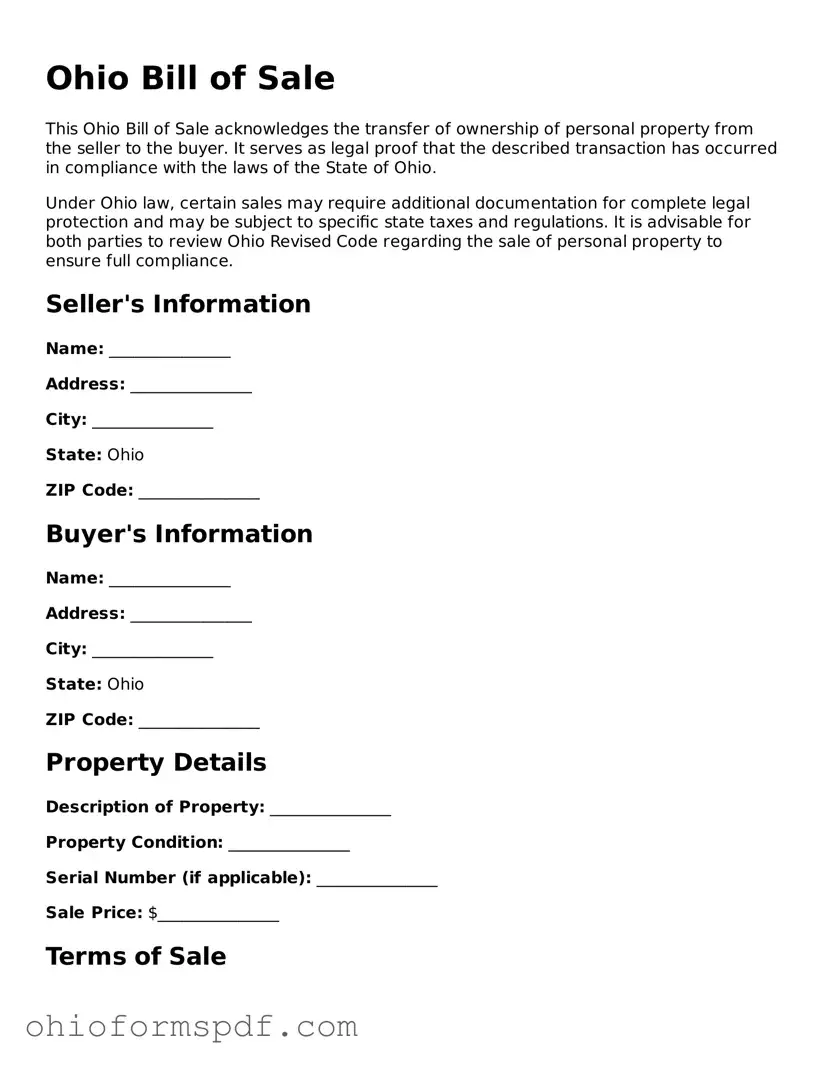The Ohio Bill of Sale shares similarities with a Vehicle Title Transfer form, often used when ownership of a vehicle changes hands. Both documents officially record the sale and purchase of a vehicle, specifying details about the buyer, seller, and the vehicle itself. However, a Vehicle Title Transfer form additionally serves to update the vehicle's registered owner and title in official state records, beyond merely evidencing the transaction.
Comparable to a Warranty Deed, the Ohio Bill of Sale provides assurance from a seller to a buyer regarding the right to sell an item, in this case, often a smaller asset or personal property. While a Warranty Deed is specifically for real estate transactions, assuring the buyer of clear property title, both documents serve to legally protect the buyer’s interests by guaranteeing the seller’s ownership and right to sell.
Similarly, the Ohio Bill of Sale is akin to a Purchase Agreement but for more immediate and straightforward transactions. A Purchase Agreement outlines the terms and conditions of a sale in greater detail and is used in more complex transactions, often involving financing terms, contingencies, and extended timelines. In contrast, a Bill of Sale is a simpler, immediate record of a transaction having taken place.
Like a Quitclaim Deed, which transfers any ownership interest the grantor may have in a property without making any guarantees about the extent of that interest, an Ohio Bill of Sale transfers ownership of personal property from one party to another. Both documents are pivotal in the change of ownership, but handle different types of property and come with varying levels of seller assurance.
An Affidavit of Title is another document with similarities, used primarily in real estate to assert the seller’s right to transfer ownership free of encumbrances (like liens or disputes). The Ohio Bill of Sale, while not typically involved in real estate transactions, similarly serves to document the lawful change of ownership, ensuring the transaction's legality and transparency.
The Ohio Bill of Sale closely resembles a Receipt in its function to document a transaction. Both provide proof of purchase, detailing what was bought, the purchase price, and the parties involved. However, a Receipt is more commonly used for everyday purchases and lacks the legal standing to confirm changes in ownership of property or items of significant value.
Similarly, a Loan Agreement shares traits with the Ohio Bill of Sale when personal property is used as collateral. Both document a change in the item’s status—ownership in the case of a Bill of Sale and encumbrance by a lien in a Loan Agreement. The key difference lies in their primary function: transferring ownership versus securing a debt.
A Promissory Note, typically used in conjunction with a Loan Agreement, outlines the borrower's promise to repay a specified amount of money to the lender. The Ohio Bill of Sale crosses paths with this document when items are sold on terms that include payments over time. Despite this intersection, their primary purposes diverge: immediate transfer of ownership versus detailing repayment terms.
An Inventory Transfer Form, used by businesses to record the movement of goods within the company or to a new owner, shares the function of documenting item ownership changes like the Ohio Cill of Sale. While the former tracks assets internally or between businesses, the Bill of Sale legally documents ownership transfer to another individual or business entity.
Lastly, a Consignment Agreement bears resemblance to the Ohio Bill of Sale, as both involve the transfer of goods. The difference lies in the nature of the transfer: a Consignment Agreement permits another party to sell goods on behalf of the owner, potentially returning unsold items, while a Bill of Sale marks the final sale and permanent change of ownership from seller to buyer.
